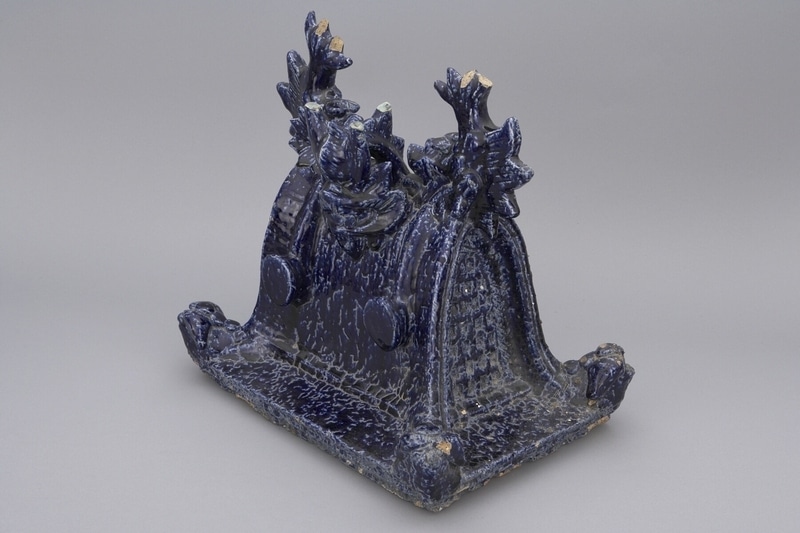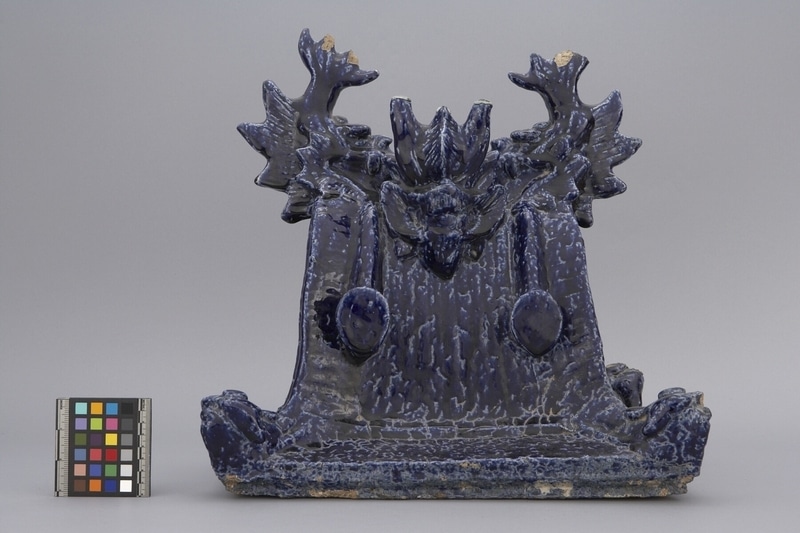Urn Lid Item Number: N2.1050 from the MOA: University of British Columbia



Description
Blue glazed ceramic lid from a funerary urn. The large rectangular lid is in shape of a palace roof. The upper ridge has a pair of three-dimensional creatures called shachihoko (鯱鉾/鯱), a mythical sea creature with the head of a tiger or dragon and the body of a fish, protruding upward at each end. Between them on the front is a dragon head. The epitaph, called migachi or miigachi (ミガチ/ミーガチ/銘書) in Okinawan, is written along the bottom of the lid.
History Of Use
The urn (body with lid) is known as a jiishigaami or jīshigāmi (ジーシガーミ)in Okinawan, and zushigame (厨子甕) in Japanese. Okinawans used to practice shinkuchi/senkotsu (シンクチ/洗骨/ bone-washing) as a form of reburial, and the washed bones were placed in such urns. Historically, the deceased were either left in the open air or placed in a large family tomb during the first period of internment, and after several years, the family would gather and clean the bones before placing them in the jiishigaami. Okinawa (沖縄) was ruled by the Ryūkyū ōkoku (琉球王国/ Ryūkyū kingdom) from 1429 until Japan annexed the island in 1879. Trade with Japan, China, Korea, and Southeast Asia influenced social practices in Okinawa, but distinct cultures in the archipelago remain vibrant.
Cultural Context
funerary urn
Narrative
The epitaph, called migachi or miigachi (ミガチ/ミーガチ/銘書) in Okinawan, reads: 長男 又吉仁王 長女 行年 十六才 又吉モウサ (Matayoshi Mousa, the eldest daughter of the eldest son Matayoshi Niō died at the age of 16) on the 28th of February in the lunar calendar in the year of Monkey in Meiji 41 (明治四十一年 甲 旧二月二十八日 死亡) or 1908.
Item History
- Made in Okinawa, Japan during 1908
- Collected by Wayne Suttles during 1954
- Owned by Wayne Suttles before 1954
- Received from Wayne Suttles (Seller) and University Purchase (Funding source) during 1954
What
- Name
- Urn Lid
- Identification Number
- N2.1050
- Type of Item
- lid
- Material
- clay and glaze
- Manufacturing Technique
- slab built and modelled
- Overall
- height 42.0 cm, width 42.0 cm, depth 32.0 cm
Who
- Culture
- Okinawan
- Field Collector
- Wayne Suttles
- Previous Owner
- Wayne Suttles
- Received from
- Wayne Suttles (Seller) and University Purchase (Funding source)
Where
- Holding Institution
- MOA: University of British Columbia
- Made in
- Okinawa, Japan
When
- Creation Date
- during 1908
- Collection Date
- during 1954
- Ownership Date
- before 1954
- Acquisition Date
- during 1954
Other
- Item Classes
- ceramics
- Condition
- poor
- Current Location
- Case 82
- Accession Number
- 2171/0129